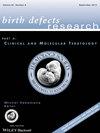A quality assessment of reporting sources for microcephaly in Utah, 2003 to 2013.
Q Medicine
Birth defects research. Part A, Clinical and molecular teratology
Pub Date : 2016-11-01
DOI:10.1002/bdra.23593
引用次数: 3
Abstract
BACKGROUND Obtaining accurate microcephaly prevalence is important given the recent association between microcephaly and Zika virus. Assessing the quality of data sources can guide surveillance programs as they focus their data collection efforts. The Utah Birth Defect Network (UBDN) has monitored microcephaly by data sources since 2003. The objective of this study was to examine the impact of reporting sources for microcephaly surveillance. METHODS All reported cases of microcephaly among Utah mothers from 2003 to 2013 were clinically reviewed and confirmed. The UBDN database was linked to state vital records and hospital discharge data for analysis. Reporting sources were analyzed for positive predictive value and sensitivity. RESULTS Of the 477 reported cases of microcephaly, 251 (52.6%) were confirmed as true cases. The UBDN identified 94 additional cases that were reported to the surveillance system as another birth defect, but were ultimately determined to be true microcephaly cases. The prevalence for microcephaly based on the UBDN medical record abstraction and clinical review was 8.2 per 10,000 live births. Data sources varied in the number and accuracy of reporting, but a case was more likely to be a true case if identified from multiple sources than from a single source. CONCLUSION While some reporting sources are more likely to identify possible and true microcephaly cases, maintaining a multiple source methodology allows for more complete case ascertainment. Surveillance programs should conduct periodic assessments of data sources to ensure their systems are capturing all possible birth defects cases. Birth Defects Research (Part A) 106:983-988, 2016. © 2016 Wiley Periodicals, Inc.2003 - 2013年犹他州小头症报告来源的质量评估
背景:鉴于最近小头症与寨卡病毒之间的关联,获得准确的小头症患病率非常重要。评估数据来源的质量可以指导监控项目集中数据收集工作。自2003年以来,犹他州出生缺陷网络(UBDN)一直通过数据来源监测小头症。本研究的目的是检查报告来源对小头症监测的影响。方法对2003 - 2013年犹他州所有报告的小头畸形病例进行临床回顾性分析。UBDN数据库与州生命记录和医院出院数据相联系,以供分析。对报告来源进行阳性预测值和敏感性分析。结果477例小头畸形确诊251例(52.6%)。UBDN确定了另外94例向监测系统报告为另一种出生缺陷的病例,但最终确定为真正的小头畸形病例。根据UBDN医疗记录摘录和临床回顾,小头畸形的患病率为8.2 / 10,000活产。数据来源在报告的数量和准确性方面各不相同,但如果从多个来源确定病例,而不是从单一来源确定病例,则更有可能是真实病例。结论虽然一些报告来源更有可能识别出可能的和真实的小头畸形病例,但保持多来源方法可以更完整地确定病例。监测项目应对数据来源进行定期评估,以确保其系统捕捉到所有可能的出生缺陷病例。出生缺陷研究(A辑)(06):983-988,2016。©2016 Wiley期刊公司
本文章由计算机程序翻译,如有差异,请以英文原文为准。
求助全文
约1分钟内获得全文
求助全文
来源期刊

Birth defects research. Part A, Clinical and molecular teratology
医药科学, 胎儿发育与产前诊断, 生殖系统/围生医学/新生儿
CiteScore
1.86
自引率
0.00%
发文量
0
审稿时长
3 months
 求助内容:
求助内容: 应助结果提醒方式:
应助结果提醒方式:


